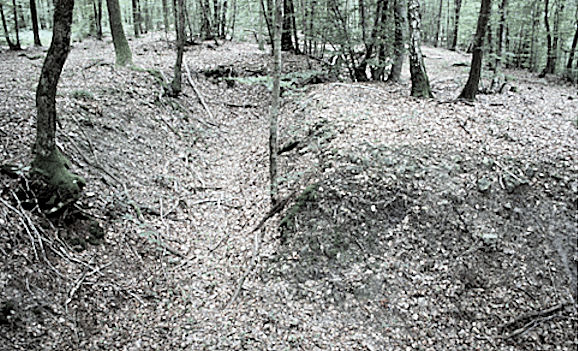Côte Dame Marie Viewed from the American Start Line
One of the more remarkable tactical victories of the Meuse-Argonne campaign was achieved by the 32nd "Red Arrow" Division of the AEF at a thickly forested and highly fortified half-mile-long curved ridge in the Romagne Heights named Côte Dame Marie. General Pershing and his chief of staff Hugh Drum believed it to be the key position during the middle phase of the Meuse-Argonne Offensive. The 32nd division was a National Guard formation made up mostly of men from Michigan and Wisconsin, who had established a track record of success during the Second Battle of the Marne. Côte Dame Marie, however, would prove their greatest challenge of the war.
There is a good reason why the largest American cemetery in Europe is located at the village of Romagne-sous-Montfaucon just a mile and half east of Côte Dame Marie. The battle for the surrounding high ground was the bloodiest AEF operation, with the highest rate of daily casualties. The German Army had concluded it was the best terrain in which to place their Hindenburg Line defenses. They called this section of defenses the Kriemhilde Stellung. Overlooking the open plains around it, Côte Dame Marie, the highest position in the region, contained a honeycomb of deep concrete bunkers and machine gun nests with interlocking fields of fire for the German defenders. Plugged into the line at the end of September were three divisions from the opening attack—the 35th, 91st, and 37th had run out of gas, and the 32nd Division found itself head-up on Côte Dame Marie, just over two miles to the north. The division began advancing on 3 October and a week later found itself at the base of the ridge. Tough fighting ensued, especially around Transvaal Farm and the approach to Romagne on the far right of the divisional sector.
As part of a three-division attack on 13 October 1918, the 32nd was ordered to assault Côte Dame Marie directly but was not expected to capture the ridge, only to keep the German defenders occupied while the 42nd Division on its left (west) and the 3rd Division on its right (east) outflanked the ridge. Unfortunately, both of the flanking movements failed in the initial assault. In the renewed attack on 14 October, the German defenders at first once again proved immovable. Then things broke perfectly for the division. On the far right, one regiment worked through a wall of barbed wire and began driving the enemy out of the village of Romagne. This opened a threat of encirclement that surely made the German command nervous. In the hills farther west, a rifle grenade team led by Captain Edward Strom first penetrated the wire in a location unobserved by the enemy and then proceeded to destroy a strategic cluster of ten machine guns.
The Red Arrow Division had won a major victory at Côte Dame Marie. The best observation post in the Meuse-Argonne battlefield was in the hands of the Yanks. The division held off German counterattacks and a massive gas assault in the following days, keeping possession of the ridge. When the 32nd Division was finally relieved after three weeks in the line, it had suffered 5,833 casualties, including 1,179 dead, many of whom today lay buried in the nearby Meuse-Argonne Cemetery. By 22 October all of the heights around Romagne were in U.S. hands. The stage was set for the final act in the Meuse-Argonne drama, the advance to Sedan.
Sources: The Meuse-Argonne works and research of Mitch Yockelson, Bob Farrell, Mac Coffman, and Ed Lengel. (All recommended)






I'd love to hear your follow-up of the advance to Sedan and the account of the First Division in that effort.
ReplyDelete